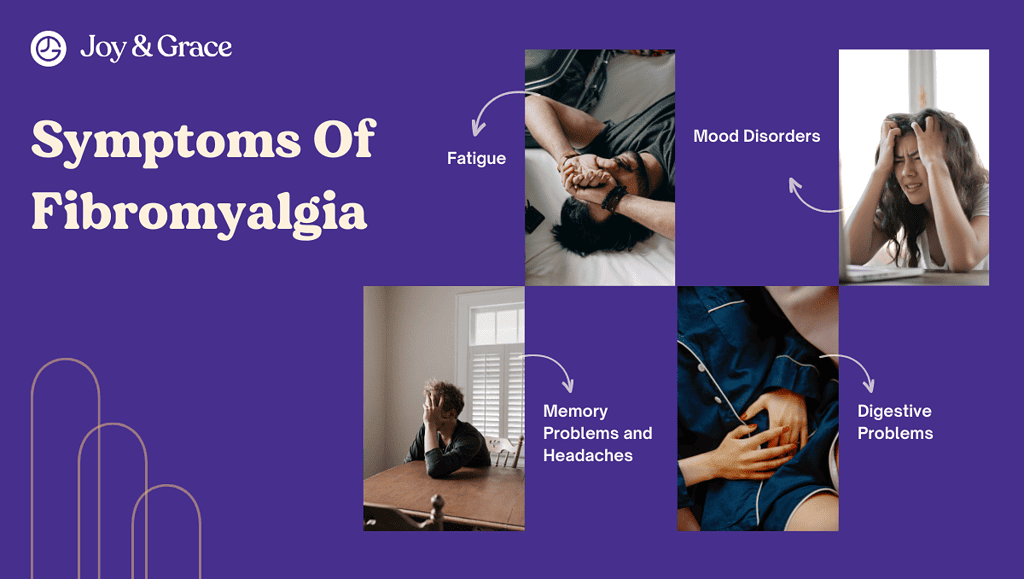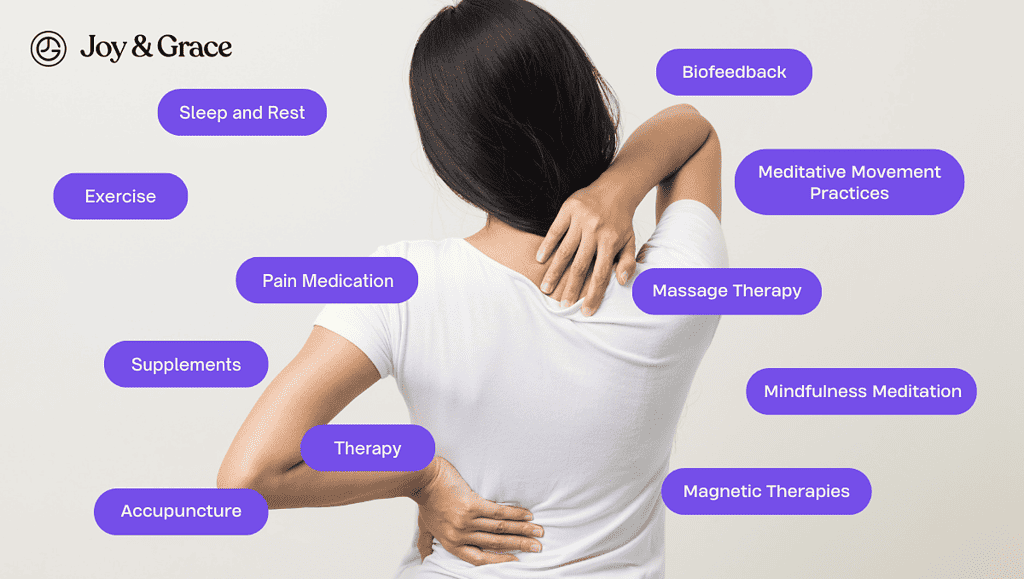No one wants to deal with chronic body pain. But 4 million US adults live with it every day. Fibromyalgia is a common illness that can happen to people of any age or gender. But middle-aged people and women are more likely to have it.
This chronic disease has many symptoms, the most common of which is chronic body pain. Shoulder pain is also a common sign of a flare-up. If any of these seem relatable to you, you might have fibromyalgia. The Joy & Grace Team has done a lot of research on fibromyalgia, how it causes shoulder pain, and how you can relieve it.
Does Fibromyalgia Affect Your Shoulder Blade?
Fibromyalgia is a chronic disease that causes widespread pain. It can also cause:
- Fatigue
- Mood swings
- Insomnia
- Memory problems
Most people with fibromyalgia report "pain all over my body." Yet, some patients may say that they hurt at "tender points" on their bodies. Most often, these are the shoulders, neck, and back.
In one study, over 70% of fibromyalgia patients complain of left or right shoulder pain. In another study, shoulder pain was often the initial complaint of fibromyalgia patients.
Pain may appear in one spot of the body but will spread to other areas as the disease progresses. People with fibromyalgia often say the pain started in their shoulders or neck but spread to other sites.
What Does Fibromyalgia Feel Like In Your Shoulder?
The pain varies from person to person and their bodies' state. People describe fibromyalgia-related pain as an aching, sore pain. You may also feel burning or pain radiating from one body part to another.
The intensity of the pain may change according to a person's stress or activity level. The time of day or temperature can also change the intensity of the pain. The pain may also come and go and change locations.
Can Fibromyalgia Cause Severe Shoulder Pain?
Yes. If you have fibromyalgia, your nervous system has an abnormal reaction to pain. The nervous system with fibromyalgia has abnormal and increased responsiveness to pain. This causes hyperalgesia and allodynia.
Hyperalgesia is when our nervous system is more sensitive to pain than it should be. If, for example, you get a flu shot, your nervous system interprets the tiny prick as very painful. This can translate to severe shoulder pain.
Another symptom associated with fibromyalgia is allodynia. Allodynia is the abnormal response of your nervous system to non-painful stimuli. This means that your body feels pain from things that don't hurt, like a light breeze or a tap on the shoulder.
These abnormal mechanisms can cause excruciating and debilitating shoulder pain. The pain does not even need a stimulus to occur.
Shoulder pain is a criterion for diagnosing fibromyalgia, but it is not enough to diagnose it.
Does Fibromyalgia Make Your Upper Back Hurt?
Yes. Tender points are symmetrical locations in your body that produce pain upon deep palpation. The upper back is part of the characteristic 18 tender points of fibromyalgia. These tender points involve the back of the neck and the shoulder blade area. These points also include areas of the chest, hips, elbows, and knees. For fibromyalgia patients, the nursery rhyme "head, shoulders, knees and toes" takes an ominous turn.
What Are The Other Symptoms Of Fibromyalgia?

Constant pain is not the only symptom of the disease. Fibromyalgia also causes a number of other symptoms, including:
- Fatigue
An estimated 90% of patients complain of extreme fatigue along with their pain. Patients often complain of being "always tired," no matter how much they rest. They may also have decreased physical endurance.
- Mood Disorders
Mood disorders are also common in people with fibromyalgia. Most of them had depression or anxiety in the past. A study suggests that psychosocial stress may play a significant role in fibromyalgia. Addressing these psychological factors may help treat the condition.
- Memory Problems and Headaches
Other common symptoms include headaches and memory problems. These issues with concentration and memory are now called “fibro fog.” But it's still unclear if this is a direct symptom or due to the pain.
- Digestive Problems
You may also have digestive problems. Abdominal pain, flatulence, and abnormal bowel movements are common. In fact, Irritable bowel syndrome (IBS) often accompanies fibromyalgia.
What Helps Shoulder Pain From Fibromyalgia?

There is no cure for fibromyalgia, so shoulder pain is something you may have to live with for the rest of your life. Even though there is no cure, you can try some things to help ease the pain.
- Sleep and Rest.
It seems easy to say, but rest and adequate sleep are essential for relieving pain from fibromyalgia. Lack of sleep is both a result and a cause of fibromyalgia. Patients with fibromyalgia complain of "non-restorative sleep." This means that despite having enough sleep, they still feel tired. They also complain of waking up in the middle of the night.
Sleep problems can aggravate stress and act as triggers for pain flare-ups.
You can do things to help you sleep better. The most helpful thing is to have a healthy sleep routine. This means going to bed at the same time every night. Staying away from screens and bright lights an hour or two before bed also helps.
Aromatherapy and heating pads can also help you calm down and get a good night's sleep. We have a scented heat pad that combines these two alternative treatments. Not only can it help you relax, but it can also ease aches and pains caused by fibromyalgia.
- Exercise
Pain and fatigue may make it hard to move, but getting your daily dose of physical activity is essential. Research shows that physical activity is one of the best ways to treat fibromyalgia-related pain. Aerobic exercises can help the most.
You don't need to go to the gym or run a sprint right away. You can start by walking outside or going up and down the stairs until your endurance grows. You can start doing easy home exercises and gentle stretching as soon as you feel ready.
- Proper Diet
According to a study, fibromyalgia patients have lower levels of antioxidants. A diet rich in antioxidants can help relieve pain and energy problems.
- Supplements
There are readily available supplements that can benefit people suffering from fibromyalgia. Some of these include:
- Melatonin
A study found that people with fibromyalgia have low levels of the hormone melatonin. Melatonin is the hormone that controls when we sleep and when we wake up. Melatonin can help ease the pain and trouble sleeping that comes with fibromyalgia.
Luckily for us, this supplement is widely available. Be careful, though, as this supplement can make you really drowsy. - Coenzyme Q10
Coenzyme Q10, or CoQ10, is a powerful antioxidant that may help ease shoulder pain caused by fibromyalgia. In a study, CoQ10 and pregabalin, a drug often given to people with fibromyalgia, helped relieve pain, anxiety, and fatigue. - Vitamin D
Studies show that vitamin D is low in fibromyalgia patients. But researchers are still unsure if the disease decreases vitamin D or if patients are more likely to be vitamin D deficient. You may not get enough of the vitamin from sources like sunlight because of symptoms.
A study suggests that Vitamin D can help with fibromyalgia symptoms, especially pain. - 5-Hydroxytryptophan (5-HTP)
Serotonin is a neurotransmitter that modulates sleep, mood, and pain perception. 5-HTP is an amino acid needed for the production of serotonin. Patients with fibromyalgia have decreased levels of serotonin.
Supplementation with 5-HTP may help achieve deep sleep and pain relief. It may also improve the mood symptoms that come with the disease. - Creatine
You may also be deficient in creatine if you have fibromyalgia. In one study, patients’ pain and energy levels improved after taking creatine. This may be due to creatine’s action on improving energy metabolism in muscle cells. Muscle cells become damaged and have impaired energy metabolism. - Acetyl-L-Carnitine
Like CoQ10, acetyl-l-carnitine is a powerful antioxidant that can protect the nervous system. It also helps modulate neurotransmitters such as serotonin and dopamine and energy metabolism. A recent study shows that it can help improve chronic pain and mood disorders associated with fibromyalgia. - S-Adenosylmethionine (SAMe)
Over the past 20 years, researchers have looked into its possible pain-relieving properties. Studies show that it can help reduce pain and depression in fibromyalgia patients. - Reishi Mushroom Powder
Reishi is a type of mushroom used in traditional medicine for more than 2,000 years. In a study released in 2017, intake of reishi mushrooms reduced pain by up to 20–30%. Participants in the study also reported improvements in sleeping problems. - Magnesium
You may also be deficient in magnesium. Magnesium deficiency is often associated with body pain, fatigue, anxiety, and difficulty sleeping. These symptoms overlap with fibromyalgia. So supplementing with magnesium may help relieve your pain and reduce stress. - Pycnogenol
Pycnogenol is also another antioxidant studied for the treatment of fibromyalgia. One study revealed that it can reduce pain intensity in fibromyalgia patients. - Capsaicin
Capsaicin is the chemical responsible for making peppers hot. Aside from adding spice to our cuisine, capsaicin is now also used as a topical pain reliever. Treatment with 0.075% topical capsaicin three times a day for six weeks can improve pain.
Don’t let its side effects surprise you. You may experience redness and stinging on the skin. - St. John’s Wort
Although it does not really treat fibromyalgia, it may help with depression related to fibromyalgia. It may also help with hyperalgesia, according to a 2010 study.
If you do decide to take St. John’s Wort, make sure to take inventory of your medications and try to consult a doctor. This supplement may cause severe interactions with certain medications, especially antidepressants. - Valerian Root
Valerian root is also a popular herb in traditional medicine. Research says it may help with sleeping difficulties and hyperalgesia due to fibromyalgia.
- Melatonin
- Pain Medication
Over-the-counter painkillers might relieve shoulder pain from fibromyalgia. Among these are acetaminophen and ibuprofen. If these drugs don't help, a doctor may prescribe more potent painkillers. Doctors can also prescribe anticonvulsants or antidepressants. These drugs can also help you achieve deeper sleep.
- Therapy
This includes occupational therapy, physical therapy, and cognitive and behavioral therapy (CBT). Out of the three, CBT is the most important. Therapy focusing on your pain and stress can help address mood and sleep symptoms.
Guided imagery is another technique that may help with symptoms. To manage your negative perception of the condition, you would be taught to focus on pleasant imagery. This may help decrease pain and fatigue.
- Acupuncture
Acupuncture may also be something you want to try, as long as you are not squeamish with needles. Although there are few studies about the use of acupuncture for fibromyalgia, it may help relieve symptoms.
We talk more about acupuncture here.
- Biofeedback
Biofeedback is a therapy that allows us to measure and control certain body functions. Electromyography (EMG) is a form of biofeedback that may help manage fibromyalgia. EMG can help you detect and control muscle tension.
In one study, EMG significantly reduced pain intensity in patients with fibromyalgia.
- Meditative Movement Practices
This includes tai chi and yoga. These activities combine exercise, meditation, and relaxation. Both tai chi and yoga may improve the symptoms of fibromyalgia. They may also improve your physical and mental health.
- Massage Therapy
Massage therapy is a safe alternative for managing fibromyalgia. Massage therapy for more than five weeks can provide immediate relief to pain.
It looks like it’s time to book a spa day. Just make sure to start with a gentle massage.
- Mindfulness Meditation
Mindfulness meditation is a form of meditation that allows you to focus on the present moment. Frequent meditation may help improve your stress, anxiety, and fatigue. It may also help to decrease pain.
- Magnetic Therapies
Extremely low-frequency magnetic fields may improve chronic pain and fatigue. One form of magnetic therapy is transcranial magnetic stimulation. This therapy may improve your pain and mood disorders.
Takeaway
Fibromyalgia is a worldwide health problem that can negatively affect a person's life. It is a debilitating disease that can keep you from enjoying life.
Although shoulder pain is a frequent symptom of fibromyalgia, it is not enough to diagnose it.
There are ways to help ease the pain and other symptoms of fibromyalgia, but self-care is the most important. Getting enough rest and sleep, as well as working out and eating well, makes all the difference.
If you found this article helpful, share it with your family and friends. Also, be sure to sign up for our newsletter so that we can keep you informed about future articles that talk about your well-being.














